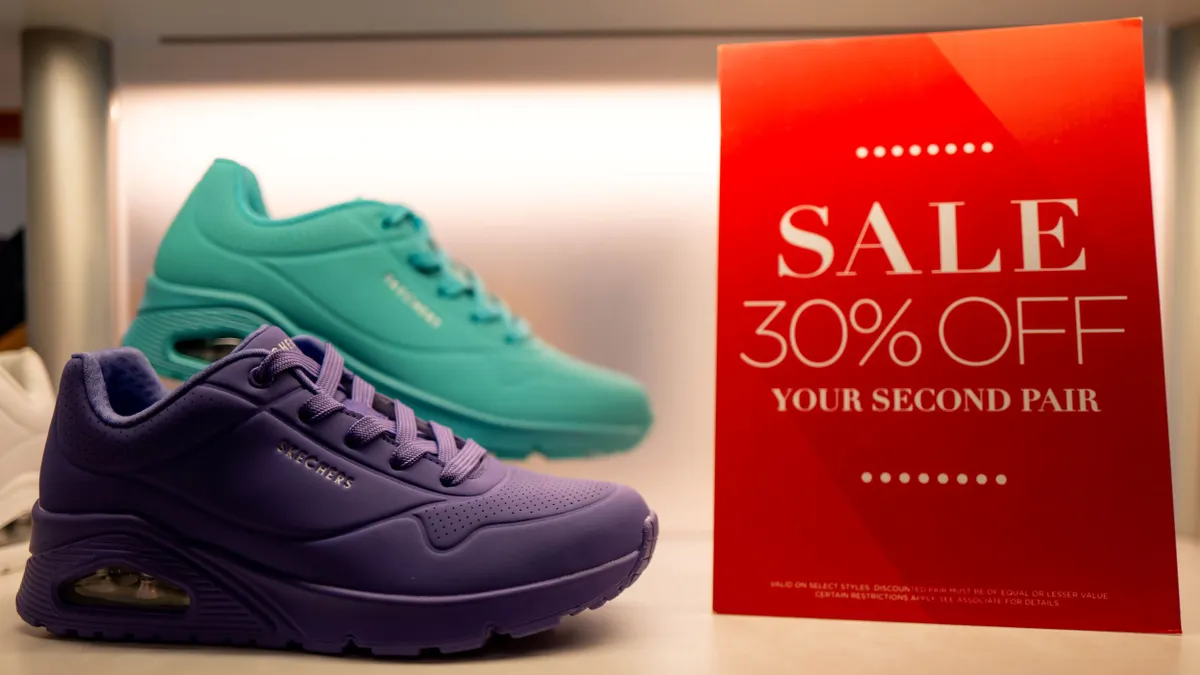Fashion, an industry long known for its discovery, creation and hyping of trends, is showing a new tendency of late: making over its C-suites by bringing on leaders whose strong suits have no prior roots in stylish suiting.
This development has not overtaken the traditional method of promoting talent from within the company. According to research shared with Fashion Dive, 26.4% of the 371 CEO appointments made by the largest 3,000 public companies in the U.S. in 2022 involved outside recruits, versus 73.6% from the inner ranks. The figures were compiled by global nonprofit business membership and research group The Conference Board with data and analytics firm Esgauge. While more than one-quarter of new CEOs are outside hires, it is actually lower than prior years. In 2021 29.3% of new CEOs came from other companies while 2019 saw an all-time high when 37.7% came from elsewhere.
This trend has also been magnified by the increase in high-profile CEO turnover in recent years due to a number of factors, including changing business models, the so-called Great Resignation and longtime leaders reaching retirement age. For instance, Levi Strauss & Co. CEO Chip Bergh, 65, who has led the jeanswear giant since 2011, hired Michelle Gass, formerly of Kohl’s and Starbucks, as the company’s new president. Gass will succeed Bergh by 2024.
Other notable executive exits in the field include Sonia Syngal departing Gap Inc. in July 2022, Steve Rendle retiring from VF Corp. four months ago, Eraldo Poletto leaving Diesel as principal after less than a year in the role, and CEO Jeff Gennette announcing his retirement from Macy’s in March after four decades with the company.
The Conference Board and Esgauge also found that the 2022 CEO turnover rate for the Russell 3000’s Consumer Discretionary sector, which encompasses industries that tend to be the most sensitive to economic cycles and includes fashion/retail, was 14.4%. This was the second highest across sectors after utilities, and 2 percentage points higher than the average recorded across the Russell 3000 Index, which serves as a benchmark of the entire U.S. stock market.
But when it comes to replacing these bigwigs, boards of directors — fashion-related and otherwise — are often welcoming fresh-blooded and modern-thinking experts to occupy the company’s most coveted corner office.
“Right now, given the dislocation in the industries in general and fashion in particular, I think the odds are tipping toward external candidates,” said Michael Jenkins, a partner in the CEO Advisory practice of Kearney, a global strategy and management consulting firm. “The requirements — if you look at what’s needed in data, technology, balancing stakeholders, the creative realm — all of those don't necessarily favor internal candidates.”
Nora Kleinewillinghoefer, an associate partner in the consumer and retail practice at Kearney, said Adidas, Under Armour, Calvin Klein, Puma and Levi’s are all big-name examples of companies bringing in outside leaders of late. “A lot of them are going external, whether it’s bringing in somebody from Marriott or bringing in somebody from a tech background,” she said.
Having a firm grasp of technology, as well as data, is an imperative job requirement for a fashion CEO, new or old, in 2023, stresses Jimmy Baratta, the newly ensconced metaverse expert in residence at Chapman University's business and economics school.
“Typically in industries like fashion and my industry, gaming, you want someone who is of the cloth. They speak the language, they know what they are talking about and they live and breathe it,” he said. “But, as the world becomes more digitally focused and enabled and we have this metaverse where every industry is rooted in some form of technology it’s really imperative that CEOs — and people of any position to be honest — have a fundamental understanding of the next generation of consumer: where they spend their time, where they spend their dollars or where they are going to spend their dollars once they become of age.”
This embracement of technology has been evident. Gucci produced a 100-unit limited edition Xbox Series X in 2021, Moncler recently produced virtual outfits for the Fortnite video game and Tommy Hilfiger expanded its partnership with online platform Roblox in June 2022.
It's usually a case of CEOs signing off on these initiatives instead of conceptualizing and nurturing these advancements themselves. Still, corporate experts stress there is no room for Luddite leaders in today’s environment.
“[Gaming] is definitely an area that incoming CEOs need to be looking at and it’s definitely an area that will continue to grow and benefit from the collaboration of these two seemingly different opposite industries,” said Baratta.
In addition to technology, the modern CEO also must be well versed in areas such as supply chain issues and important concerns that were barely factors a decade or so ago, such as diversity, inclusion, traceability and fashion’s favorite new buzzword, sustainability.
“The role of a CEO at a fashion brand or luxury retailer has become way more complex. You have to understand merchandising and have a good portfolio of products and have great relationships,” notes Garrett Sheridan, CEO of Chicago-based Lotis Blue Consulting. “You really do need to understand sustainability and workplace diversity. Boards are looking for leaders who have a broader lens on everything.”
Innate curiosity and a keen desire to master all aspects of the business – especially new ones – are other essentials for new CEOs, whether they are company natives or newcomers, Sheridan added.
“We are moving away from career ladders where you simply join a company and spend 15 years there and move up the rungs,” Sheridan said. “Maybe they start with sales and they understand consumer marketing and then after a while they end up running distribution centers. You kind of layer on those different experiences and you end up with leaders who have been exposed to more parts of what is required to run a large business or a large fashion brand.”
Kleinewillinghoefer, however, points out that there is a cautionary side to hiring outsiders to run fashion brands. She firmly believes old school CEOs still have plenty of knowledge to impart to industry novices, such as being able to pick the right product.
“You have to maintain that brand identity,” she said. “Because, ultimately, at the end of the day everybody can create a product but what makes it distinctive and unique is what that fashion CEO brought versus that new CEO who has to learn and maintain that skill set while bringing that broader capability to the forefront.”
Most agree, though, that the practice of converting top brass to the clothing world rather than promoting from “off the rack” is here to stay.
“This trend that we’re seeing where organizations seek different leaders is just going to pick up in pace,” Sheridan said. “Knowing how to cut a pattern or design a suit or any kind of apparel is now less important than running the business and engaging employees and speaking to the market.”


















